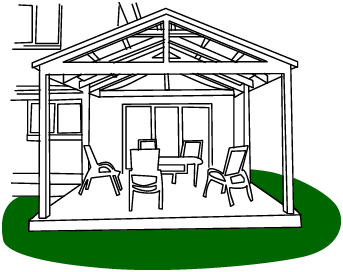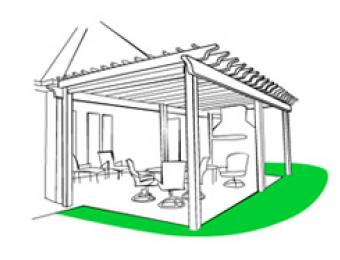
While there are different styles of roofs, claddings, materials and features, there aren't any hard and fast design rules regarding what you can and can't use. In many senses, the best approach to the 'design' aspect of your pergola is to identify your purpose, consider the basic requirements you'll need in terms of shape and size, and then figure out the best way to make your pergola complement your house and garden. Here are some points you should consider when making your plans:
Open or closed roof
Whether you want to have your pergola completely covered, partially covered or wide open will affect when you can make use of it. A pergola fully clad with a steel roof, for example, will offer shade from harsh sun and shield you from the rain. This might be great for use as a barbecue area, but these points may count against it in a fernery setting where access to water and sunlight is a plus. Traditional pergolas are open roofed, with trellises allowing vines and creepers to grow across them, but modern pergolas can be covered with shade cloth, sails, translucent acrylic roofing or even thatch to offer varying degrees of weather protection.
That's not to say you absolutely have to decide on one option or the other though - you can clad part of your pergola if you choose, or even use a system that allows you to open or close your pergola roof as you please.
Environmental factors
You will need to know a number of things about the positioning of your pergola; where the sun rises and sets, which way the strongest winds blow, the locations of nearby trees and where they are likely to grow, whether there are any bodies of water to plan around, which areas are visible to neighbours and so on. Planning ahead for the surroundings will inform your design. You may wish to incorporate screening on certain parts of your pergola, for example, for reasons of privacy or to block the wind. Likewise, you may want to include partial cladding over a certain portion of the roof to block out the strongest midday sun.
Choice of colours and materials
Taking the above points into consideration, you can then play with some ideas for materials. Combining materials can lead to some striking results which both look impressive and enhance the functionality of your pergola. For example, covering part of your pergola with shade cloth and fully cladding another part with steel will give you a warm, open space to sit under when the weather is fine and a shielded area to protect from the rain when it is not.
When you're choosing your materials and colours, give some thought to the period style of your home. Constructing a pergola from ultra-modern materials in the backyard of a period home is likely to look weird, and to reduce your home's resale value. The same goes for fine detailing - small touches and flourishes can make a big difference.
Choice of shape
The way your pergola is shaped will play the biggest role in its aesthetics. Symmetrical or asymmetrical? Freeform or geometric? Will your pergola be a lean-to or otherwise attached to the house, or will it need to stand on its own? Do you intend on having a sloping or flat roof? The shapes you can come up with should complement the surrounding environment and take account of weather factors too.
